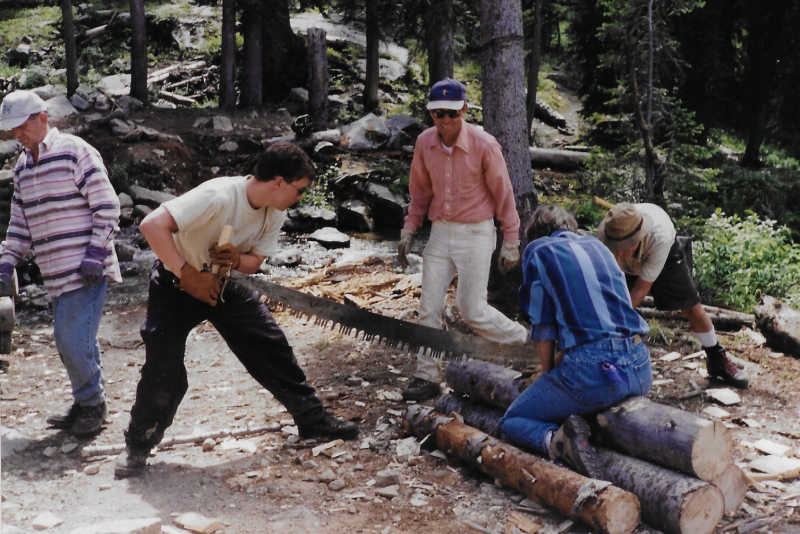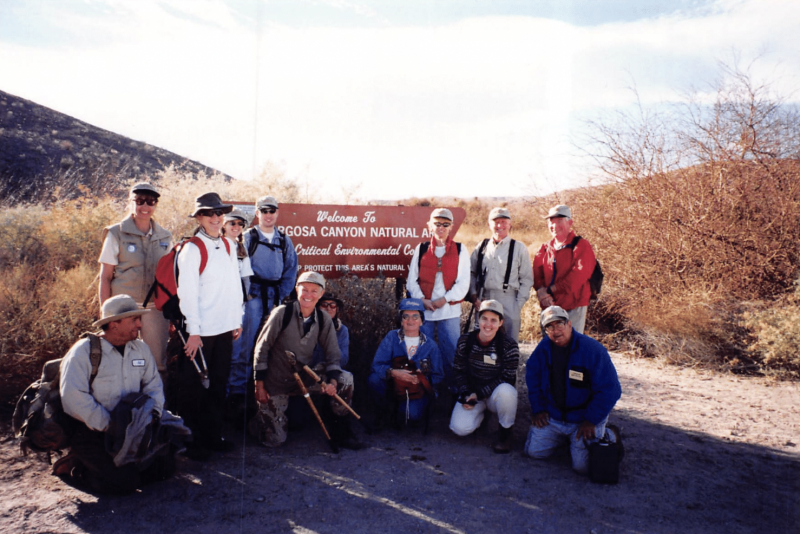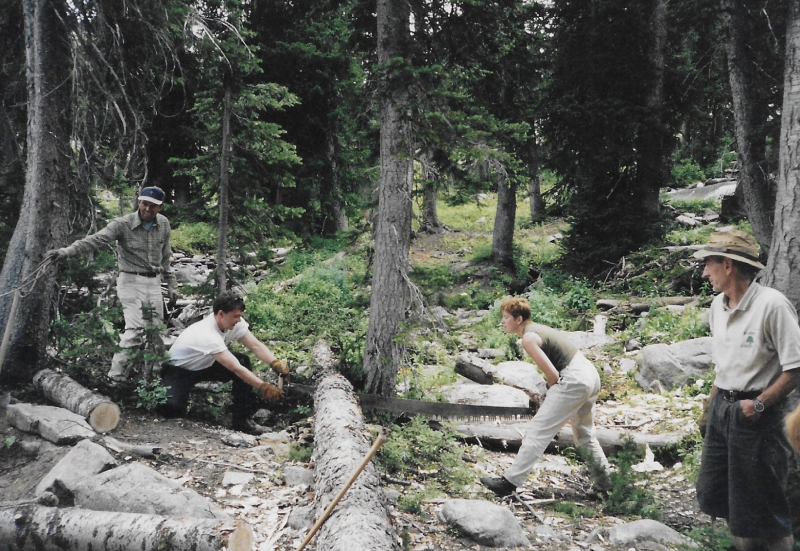50 Years of Volunteers!
Join us in celebrating 50 years of Volunteer Vacations as we sit down with Bill Ruskin, AHS’s Volunteer Vacations Program Founder.

You were instrumental in starting the Volunteer Conservation Corps which became the American Hiking Society Volunteer Vacations program. Can you share how the VCC came to be?
From hiking with the Boy Scouts while growing up in Pennsylvania to working on trails at Philmont Scout Ranch in New Mexico to joining a trail crew in the Bob Marshall Wilderness in Montana to digging fire line on a USFS Hotshot Crew, to volunteering with other smokejumpers on trail and restoration projects, to hiking in Germany and Austria, and finally from over 50 years of living in Colorado, trails have been my way of life.
While serving in the U.S. Army in Germany, I was assigned to train with the Royal Norwegian Army and one of my duties was as a ski instructor for NATO troops in Norway. Spending two winters there, I realized that cross-country skiing would eventually become very popular in America.
In 1970, after my military service, we adopted Colorado Springs as our family’s new home. My work as an Open Space Planner with the Pikes Peak Area Council of Governments quickly revealed the need for many more nearby hiking and ski touring trails. Combining my cross-country ski experience in Norway with my love of hiking, I recognized there was no organization in this country that was helping its people enjoy hiking and cross-country skiing. At the time I felt there should be a program for the average American who isn’t a wilderness purist but enjoys all that it has to offer. I also discovered the existence of Public Law 92-300 allowing individuals to work in national forests, giving volunteers temporary rights and protection as federal employees, if injured. I also saw the problems the US Forest Service had from a shortage of funds to build and maintain trails in the national forests.
This led me to create the non-profit National Hiking & Ski Touring Association (NAHSTA) in 1971. The Volunteer Conservation Corps (VCC) idea evolved as one of the programs of NAHSTA and its purpose was to mobilize volunteers and sponsors to donate labor and materials for building new trails. NAHSTA was the first organization to sponsor such a program nationally in conjunction with Volunteers in the National Forests Law (PL 92-300).
In 1973 I left government service to join the Swedish Silva Compass Company as Director of the American Orienteering Service. Silva became a major sponsor of the VCC providing both funds and a compass for each volunteer. Silva also sponsored the production of the film, New Trails, now available on YouTube.
A “help wanted” ad placed in Better Camping magazine, Fall 1973 issue, generated over 1200 responses and I had a ‘tiger by the tail’. Apparently there were thousands of people, average citizens with a variety of backgrounds and interests, willing to give up their vacations to work in their national forests in Colorado, for no pay. Later, a one-inch ad in Backpacker magazine also generated thousands of additional replies.
Overwhelmed by the response, I had to decide what to do next. Only 58 volunteers could be accommodated for the pilot VCC project at the Monument Environmental Center in Colorado. Fortunately, the Denver Regional Office of the USFS became enthused about the volunteer program and recruited over 100 of the applicants to work on the Colorado Trail, which like the VCC was in a start-up phase. Now completed, it extends 500 Miles from Denver to Durango.
Further, once the word got out about this program, and since there were no federal funds available, we had to make an appeal for private financial and material support. Again, we were overwhelmed with the private support we received both locally and nationally. This was like picking low hanging fruit. Anything we needed and requested came rolling in.
First, the Colorado Springs’ Gazette Telegraph ran two editorials and a dozen articles, before, during, and after the project which generated a lot of support from local businesses. This included refrigerators, cooking pots, stoves and other necessities. But we still needed everything you can imagine, such as tents, sleeping bags and backpacks.
Soon our needs went national and we received family size tents, sleeping bags, freeze dried foods, bug repellent, backpacks and compasses. Donors included JCPenney, Sears Roebuck, Camel Company, Camp Trails, Chuck Wagon Foods, Johnson Wax, Pauli Products, Silva Company, Eureka Tent, Oregon Freeze Dried Foods, and the Colorado Mountain Trail Foundation of Denver.
The idea eventually spread all over the country, and received an official endorsement from then President Carter in 1978.


Based on our records, nearly 17,500 volunteers have been on an American Hiking Society volunteer trip, contributing nearly 700,000 volunteer hours across nearly 2,000 trips contributing nearly $13M in volunteer labor value alone. Beyond the numbers, what have been the biggest impacts of the Volunteer Vacations program?
I think the biggest impact of Volunteer Vacations has been on the individual volunteer. There is something unique and special about trail work and related activity in the forest. Once you take that first swing with a Pulaski or begin sawing a log with a cross-cut saw, you soon forget about everything else. People want to get involved and they want to get their hands dirty and boots muddy. At the end of a day they hike back to camp over a trail they just built with a big smile and a great sense of accomplishment. This in turn impacts their friends, their families, and spreads—ultimately benefiting our entire country and its trail systems.
Equally important, Volunteer Vacations provides an opportunity for the volunteer to create a sense of stewardship for the land. The exposure to conservation work in a national forest has likely influenced some volunteers to seek careers in a related field. In today’s high-tech world many young people need more time outdoors. Participating in a Volunteer Vacations project gets the volunteer into a natural environment and away, at least temporarily, from computers and phones where they spend most of their time.
How many Volunteer Vacations have you personally been on? What is a key highlight or memory of those experiences?
I did so much administrative work in those early years, I couldn’t get directly involved with many of the projects—there were just too many, which proved the organization had become a resounding success! From 1973, when we ran the ad in Better Camping magazine, until 1978 when AHS took over, I was almost totally involved with the coordination and planning for all VCC projects. Despite all the administrative work, I was able to visit some of the camps in those early years, although I no longer remember how many. The best part was seeing all the happy faces of people enjoying the project and thanking me for helping get them there. And I of course thanked them in return for being there!
Who was impactful in your experience with American Hiking Society and Volunteer Vacations?
Jim Kern, Florida Trail Association, founding Director of American Hiking Society.
Bill Kemsley, Backpacker Magazine, founding Board member of AHS.
Bjorn Kjellstrom, Silva Compass Company, a strong supporter of the VCC program, a founding Director of AHS, and sponsor of the film production of the first VCC project, New Trails. This film, originally a 16mm production, has been digitized and can now be seen on YouTube.
Bill Lucas, Regional Forester, Rocky Mountain Region, U.S. Forest Service. Lucas said, “We [in the Rocky Mountain Region] endorse the Volunteer Conservation Corps concept and performance and will continue to extend our fullest cooperation.”
What do you hope the legacy of Volunteer Vacations will be?
I hope it will be a continuation of the American tradition of both preserving and enjoying the great outdoors. Teddy Roosevelt and Gifford Pinchot would be very proud of AHS for what has been achieved on our national forests over the past 50 years through the Volunteer Vacations program. Creating the national forest system of 180 million acres is the legacy of Roosevelt and Pinchot and helping to preserve, enhance and promote the wise use of the national forest system is the ongoing legacy of Volunteer Vacations.

What piece of advice would you give for someone who has never been on a Volunteer Vacation before?
I would tell them to be prepared for the experience of a lifetime. It won’t be easy, but it will be worth it. They will have long but rewarding days. They should be prepared to get dirty and to face new challenges. They should bring the best gear they can afford and a hearty appetite. Strangers at the beginning of their project may become lifelong friends by the end of the project. I would also advise them to prepare to be changed for the better. Volunteers will handle tools and solve problems, which leads to an increased sense of self-reliance, accomplishment and teamwork. Ultimately, they will leave knowing they’ve left an indelible mark on America’s great outdoors.
What do you hope to see for the next 50 years of Volunteer Vacations?
If the past 50 years generated over 17,000 volunteers donating nearly 700,000 hours of their time on 2000 projects, I would love to see even stronger numbers of enthusiastic volunteers giving even more hours. With increasing use of our public lands with each passing year, the next half century will really need those volunteers. Just as important, as technology continues to change at a rapid pace, nature thankfully remains the same. Whatever technology looks like over the next 50 years, it will be important for people to get out into the outdoors, and Volunteer Vacations and the AHS are key to making that possible for future generations of Americans.
Personally, I would also love to see the AHS cooperating with other outdoor organizations to establish a National Hiking Center and Museum, perhaps in Colorado Springs, the home of the successful Volunteer Vacations.

What makes American Hiking Society special? What makes Volunteer Vacations special?
I think the name of the AHS itself is special. Most of us are proud to call ourselves an American. The word Hiking is music to the ears of many people, and Society garners the feeling of belonging to something bigger and more important than just ourselves. The AHS is the perfect fusion of all of these.
Volunteer Vacations is special because it offers an individual an opportunity to visit some remote and most beautiful places on public lands throughout the U.S.A., and without spending a lot of money. The volunteer has a broad choice of locations from which to choose and can select the job most suited to their skills. While on a project, the volunteer will meet new friends. They will camp, hike, fish, and generally have a good time while performing a valuable service. Thousands of individuals inquiring about Volunteer Vacations stated that they had previously enjoyed the outdoors on public lands, and next wanted to participate in a Volunteer Vacation because they were ready to give something back.
